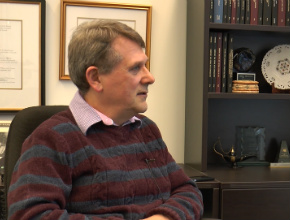References
Carson JL, Guyatt G, Heddle NM, et al. Clinical Practice Guidelines From the AABB: Red Blood Cell Transfusion Thresholds and Storage. JAMA. 2016 Nov 15;316(19):2025-2035. doi: 10.1001/jama.2016.9185. PubMed PMID: 27732721.Roman Jaeschke: Good afternoon. Welcome to another edition of McMaster Perspective. Reintroducing Professor Gordon Guyatt, the person who coined the term evidence-based medicine. Gordon, you participate in a lot of different practice guidelines. The last one I have seen was done by the American Association of Blood Banks.
Gordon Guyatt: No, no. By the AABB, which no longer is the American Association of Blood Banks, but just the AABB.
RJ: That is a good way to start. What led to these particular guidelines and what were the questions considered?
GG: There were 2 fundamental questions. One was the threshold. When somebody is anemic and you are thinking – particularly hospitalized patients was the focus here – when a hospitalized patient is anemic, how anemic do they have to be before you should give them a blood transfusion? That was one issue that has been quite controversial. Another issue was the issue of fresher versus not so fresh blood. Thresholds differ but blood is now typically given up to, say, 40 days, and the question was, “Would much fresher blood be of benefit?”
RJ: By fresher you mean just taken from the donor and transfused?
GG: Yes, appreciably less than 40 days. There were biologic reasons to think that the fresher blood might be better. Once we see the results, there may also be biologic reasons why it is worse, which is the usual, unbearable lightness of physiologic reasoning.
RJ: What kind of conclusions have you drawn?
GG: You might say, “Why did we go back?” – as we went back – because since previous guidelines there were new trials.
RJ: Why did you go back?
GG: Because the new trials might have shown something different or they might have, as it turns out, strengthened conclusions from prior data. Prior data had suggested that in most – if not all – hospitalized patients there are no additional benefits of a higher threshold, such as 10 g/dL, over a lower threshold of 7 to 8 g/dL. Prior trials suggested that, and all the new trials suggested that. So these are extremely consistent results across trials of no apparent benefit for a higher transfusion threshold of the order of 10 g/dL than a lower transfusion threshold of the order of 7 or 8 g/dL.
RJ: Would you interpret it as a recommendation not to transfuse until your hemoglobin reaches 70 g/L [7 g/dL]?
GG: In the vicinity of 70 g/L – yes, with the proviso that it does not suggest to abandon clinical judgment, and [you have to] look at the individual circumstances. And that is true for any guideline. In other words, guidelines can be for average patients only, they cannot be for special circumstances or idiosyncratic patients, where even strong recommendations may not be appropriate in all situations. So, “but it says…”, unless you have such a situation that for whatever reason the clinician thinks this is different, restricting transfusions to under 8 g/dL and in the vicinity of 7 g/dL would seem to be quite strongly supported by the evidence.
RJ: I will dig a little bit deeper. It is clear that we should not start transfusing at 10 g/dL [100 g/L], but would it be considered inappropriate, with the same strength of conviction, not to transfuse people at 85 g/L or at 80 g/L, even if they have no additional risk factors?
GG: To start off with what you said that we should not transfuse at 10 g/dL – why not? Not because it is going to hurt people much at 10 g/dL. In other words, what are the downsides of transfusing at 10 g/dL? Number one: people get more blood. If you set a threshold at 10 g/dL, people get appreciably more blood. There are risks of blood transfusion, although they are very small, and so remote. That is one thing. And secondly, blood is scarce and precious, and so you are using blood unnecessarily. As it turns out, if you compare – as some trials do – the threshold of 7 g/dL to a threshold of 10 g/dL, there are no differences in mortality, no difference in really anything important that one could bring up.
RJ: Other than blood use.
GG: Other than blood use – that is right. And in fact, for some of the [trials], the trend is towards doing better with the lower transfusion threshold. Then another set of trials compared 8 to 10 g/dL – same thing. Really, no benefits of the higher threshold. What can one deduce from that? It seems reasonable to deduce that… I would be very surprised if there were a benefit of 8.5 g/dL over 7 g/dL, for instance. That would be very surprising to me given the data.
RJ: Are there any populations to which those recommendations do not apply?
GG: It was a matter of controversy in the panel, but in the end the decision was that in people with acute coronary syndrome and in people with thrombocytopenia the panel refused to make a recommendation. Which means that things are much more uncertain in such [patients].
RJ: Any direct evidence for this coronary population?
GG: The reason for the coronary population is that small trials with very few patients suggest a possible harm with the low transfusion threshold, which we otherwise recommend. Small enough numbers that if you do the statistical test, there is no convincing difference between the groups, which left me comfortable saying, “Well, my suspicion is that it is no different with acute coronary syndrome if we had the numbers.” However, if you are wrong setting a threshold of 7 g/dL, what are the consequences? Maybe more people die if you set a threshold of 7 g/dL. If you are wrong with a threshold of 10 g/dL, and give 10 g/dL, what happens? People get more blood. So it seems that probably 7 g/dL is the right threshold, but if it is wrong, the consequences are more dire than if you give 10 g/dL in the threshold.
RJ: So the bottom line is, let’s not be dogmatic about that particular threshold and this particular population.
GG: For sure.
RJ: Thank you very much for this part. Now, how about the duration of blood storage?
GG: The duration of blood storage is something of an interesting story. People had the basic science work suggesting that there might be some benefits of fresher blood and they started doing trials of fresher blood. Negative, negative, negative, and negative. In other words, no benefits for the fresher blood. But it was one of those things that people find difficult to let go of, so they kept doing trials and trials. So when we made our recommendation, it was only moderate-quality evidence that fresher blood was of no benefit because the confidence intervals were pretty narrow; but if you are talking about mortality, things have to be very tight before you would say we have high-quality evidence for fresher blood. So, another very large trial was published subsequent to our guidelines which again confirms that fresher blood is of no benefit. This time the confidence interval was very narrow, except on the harm side of fresher blood. Obviously, there are huge downsides in terms of feasibility, logistics, cost, practicality of moving to a fresher blood threshold. With the current data, nobody is going to do it except – in my understanding, not that it is my area at all, of course – people giving transfusions to neonates.
RJ: We need fresh blood.
GG: Yes. One interpretation of our data, not unreasonable, is that – if anything – the fresher blood seems to be harmful. By selectively using fresher blood in neonates, maybe you are harming them. That is if I were looking at our data; the neonatologist might have some...
RJ: ...physiological rationale.
GG: Yes. But so far, the physiological rationale has failed miserably. Why would one, given that the physiological rationale in other populations has failed miserably, why would one think it would do better in the... So, I would have thought you would not give fresher blood to these kids until you have evidence that it is beneficial.
RJ: Thank you, that is very useful for all of us. Thank you very much. I guess the young people – young blood.
 English
English
 Español
Español
 українська
українська










